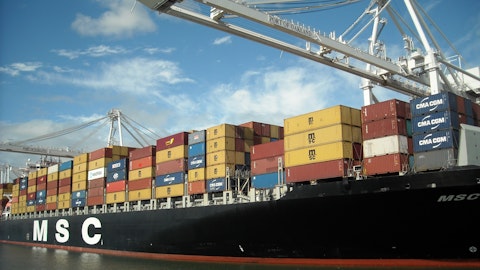The future years may see the recovery in our industry, but clearly for us today we’re taking a very cautious view of the coming quarter — and should I say the coming quarters, including the full year of 2024. We will obviously guide in more detail our view for 2024 in a few calls from now. It’s a little bit early for us to guide the market. But by and large, we expect that the industry will be under severe pressure and challenged for the foreseeable future.
Omar Nokta: Understood. Thanks, Xavier. That’s it for me. I’ll turn it over.
Operator: Your next question comes from the line of Sam Bland from JPMorgan. Please go ahead.
Sam Bland: Thanks for taking the question. I have two, please. The first one is sort of the same point on the sort of timing of the charter renewals. I guess, we’ve done 25 more this year, 34 next. It’s similar to the last question. Does that sort of mean that there’s, I don’t know, 50, 60 or something in 2025? Are those also at sort of high COVID-era prices? And is there anything you can do to maybe bring them forward? Obviously, you got to do that with agreement from the tonnage provider. And the second question is, if you look at the — where rates are today, you said, they’re obviously low, but the newbuilds are quite cost competitive. How would you sort of characterize whether sort of current spot rates are profitable or not for the newbuild ships with their cost base? Thank you.
Xavier Destriau: Thank you, Sam. So, to your first question, in terms of — you’re right in saying that we have 34 vessels that come up for renewal in 2024. We have close to 40, not 50, but close to 40 that will come up for renewal in 2025 as well. So — and those could be characterized potentially as well as higher chartered capacity in terms of daily rate. So that will continue to unwind in the year subsequent to 2024. But we will already have redelivered in combination 59 vessels by the end of 2024. When you asked the second question in terms of do the rate today would cover the cost of the new capacity that we are bringing in, that’s a difficult question to answer because it is also very much a function of our ability to fill the ships, obviously.
So, if we are in a situation where the ship do sail because the capacity — the filling factor is satisfactory, then we are in a better — in a much better position with the new capacity. To give an indication, I think I already used this illustration on a couple of occasions, but the 15,000 TEU LNG ships that we are now gradually deploying on our Asia to the U.S. East Coast trade lane, around — it will cost the same to operate the 10,000 TEU ship that they come and replace. So we get a 50% additional intake at the same — more or less the same cost of a given voyage. So that illustrates the magnitude of the benefit that we expect to get from those vessels that come in in terms of charter at competitive price. But on top of it, we expect to get additional savings by running them on LNG, which today is a source of fuel, which is more cost-effective than even a heavy fuel.
Sam Bland: Okay, understood. Thank you.
Operator: Your next question comes from the line of Alexia Dogani from Barclays. Please go ahead.
Alexia Dogani: Yeah, thank you for taking my questions. I had three as well. Just firstly, obviously, I appreciate the $3 billion liquidity you currently have on your balance sheet. What do you think is the minimum liquidity you are able — or want to operate the company at? That would be helpful. Secondly, can you remind us the down payments for the new vessels in ’23 and ’24 as part of these long-term agreements? I think you mentioned the number in Q1. It would be great if we can just double-check that. And then, finally, in terms of the depreciation run rate in Q4, I mean, if I annualize the number, I think it’s around $1 billion now. Should we still assume, though, the kind of rough annual charter costs, in terms of cash to be around $1.4 billion? Thanks.
Xavier Destriau: Thank you for the question. So the — your first question, which is in relation to what is the minimum cash that we would want to be keeping, it’s difficult to answer that question today, because clearly we are and the industry is in a transition phase, is not — has not stabilized yet. And clearly, on some of the trades, the rates are unsustainable for the longer term. So, we wish to be very cautious here, and I don’t think we have a right amount for us to provide at this stage. We want to make sure that we navigate the current turmoil in our industry with a strong balance sheet. And I think this is the case today with the $3 billion that we have sitting on our balance sheet. But with clouds on the horizon, we need to be very mindful of our liquidity position.



